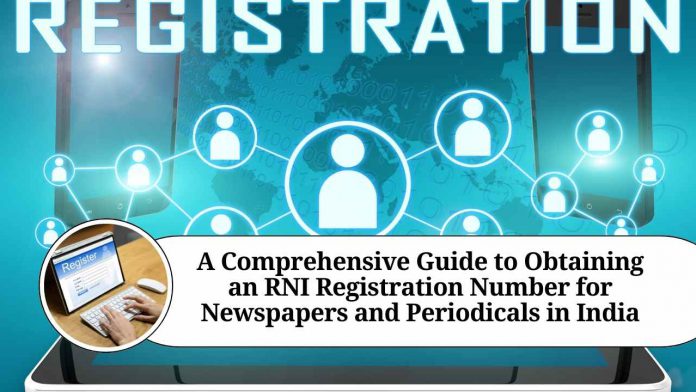Introduction:
If you are involved in the publishing industry in India, specifically as a newspaper or periodical publisher, obtaining an RNI (Registrar of Newspapers for India) registration number is essential. The RNI registration number acts as an official recognition of your publication and grants various benefits, including eligibility for government advertisements, protection of intellectual property rights, and access to certain government schemes. In this blog post, we will guide you through the process of acquiring an RNI registration number.
Step 1: Understand the Requirements Before you begin the registration process, it is crucial to familiarize yourself with the necessary prerequisites. To obtain an RNI registration number, you must ensure that your publication meets the following criteria:
- Your publication should be printed and published in India.
- It must consist of news and current affairs content.
- The publication should be issued at regular intervals, such as daily, weekly, or monthly.
Step 2: Gather Required Documents To proceed with the registration, gather the following documents:
- Duly filled application form (Form I) available on the RNI website.
- A notarized affidavit, attested by the publisher, stating the ownership and particulars of the publication.
- A notarized declaration, attested by the publisher, regarding compliance with the Press and Registration of Books Act, 1867.
- Original copies of relevant newspaper clippings or photocopies of the periodical.
- Proof of payment of the prescribed registration fee (demand draft or e-payment receipt).
Step 3: Prepare the Application Once you have the necessary documents, carefully fill out the application form (Form I) provided by the RNI. Ensure that all the details are accurate and complete. Attach the supporting documents mentioned above, making sure they are organized and arranged in the order specified in the guidelines.
Step 4: Submit the Application Once you have prepared the application, you can submit it to the RNI office. The RNI has multiple offices located across India, so ensure you send your application to the appropriate regional office. You can find the contact information for the regional offices on the RNI website.
Step 5: Verification Process After submitting the application, the RNI will initiate the verification process. During this stage, the RNI will review the provided documents, conduct inquiries, and inspect the printing press. The verification process may take several weeks or months, depending on the workload and complexity of the application.
Step 6: Grant of Registration Number Upon successful completion of the verification process, the RNI will issue a registration number for your publication. This number will be unique to your publication and will be valid for a specific period. The RNI will notify you of the allotted registration number through a formal communication.
Conclusion:
Acquiring an RNI registration number is a significant step for newspaper and periodical publishers in India. By following the steps outlined in this guide, you can navigate the registration process smoothly and ensure compliance with the necessary requirements. Remember to stay updated with any changes or additional guidelines issued by the RNI to ensure a successful registration experience.
Read more useful content:
Frequently Asked Questions (FAQs)
Q1: Who is eligible to apply for an RNI registration number?
A1: Publishers of newspapers and periodicals that are printed and published in India and consist of news and current affairs content are eligible to apply for an RNI registration number.
Q2: How can I obtain the application form for RNI registration?
A2: The application form (Form I) can be downloaded from the official website of the Registrar of Newspapers for India (RNI). It is available in a printable format for you to fill out and submit.
Q3: What is the registration fee for obtaining an RNI registration number?
A3: The registration fee is subject to change, and the current fee can be obtained from the RNI website or by contacting the regional office. The fee can be paid through a demand draft or via e-payment.
Q4: What is the significance of an RNI registration number?
A4: An RNI registration number serves as official recognition for your publication and provides various benefits, such as eligibility for government advertisements, protection of intellectual property rights, and access to certain government schemes.
Q5: How long does the verification process usually take?
A5: The duration of the verification process varies depending on the workload and complexity of the application. It can take several weeks to months to complete the process.
Q6: Can I submit my application to any RNI office in India?
A6: No, you need to submit your application to the appropriate regional office based on the location of your publication. The contact information for regional offices can be found on the RNI website.
Q7: Is it mandatory to have a physical printing press for obtaining an RNI registration number?
A7: Yes, as part of the verification process, the RNI may conduct an inspection of the printing press to ensure compliance with the guidelines.
Q8: What happens if my application is rejected?
A8: If your application is rejected, the RNI will provide reasons for the rejection. You can rectify the deficiencies and reapply for the registration.
Q9: Is there a validity period for the RNI registration number?
A9: Yes, the registration number is valid for a specific period, typically a year. It needs to be renewed before the expiry date to maintain the validity of the registration.
Q10: Can I make changes to my registered publication after obtaining an RNI registration number?
A10: Yes, you can make changes to the publication, such as the title, periodicity, and language. However, you need to inform the RNI about such modifications and follow the prescribed procedure for updating the registration details.




















